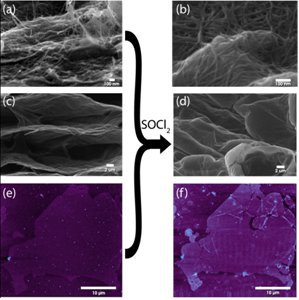Highlight Photo
Highly Conductive Transparent Films Based on Graphene and Carbon Nanotubes
Figure 1. Scanning electron micrographs (SEM) of graphene-CNTs nanocomposites, CCG and an atomic force micrograph (AFM) of a single CCG sheet.

Figure 1. Scanning electron micrographs (SEM) of graphene-CNTs nanocomposites, CCG and an atomic force micrograph (AFM) of a single CCG sheet. The SEMs of the nanocomposite (a) before, and (b) after SOCl2 treatment indicate that the carbon nanotubes bundle up on top of the graphene layers. © SEMs show increased overlap between graphene layers after (d) doping with SOCl2. AFM images of CCG (e) before and (f) after treatment suggests that exposure to thionyl chloride can be detrimental to the overall fidelity of a graphene flake. This anionic dopant does not induce intercalation and folding, but rather, rips and wrinkles.
Credits: Kitty Cha and Jonathan Wassai






